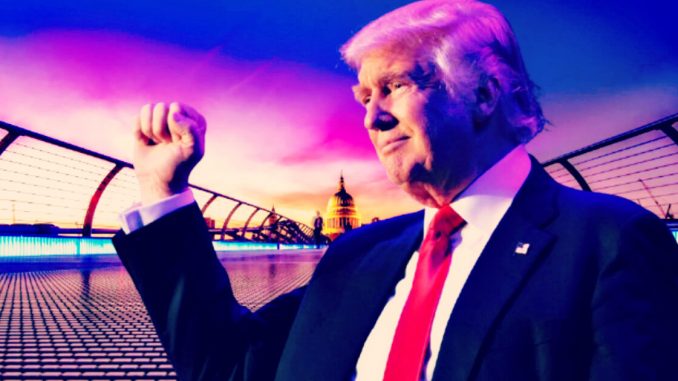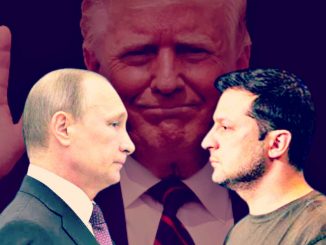
| Published August 26, 2025
In a candid moment at the White House, President Trump dismissed Russia’s recent provocations with a blunt remark, hinting at deeper tensions.
In a recent White House cabinet meeting on August 26, 2025, President Donald Trump dismissed the latest developments in the Russia-Ukraine peace negotiations as mere “posturing,” calling them “all bullsh*t.” This blunt assessment came after Russian Foreign Minister Sergey Lavrov asserted that Moscow would not sign any peace agreement with Ukrainian President Volodymyr Zelensky, citing Zelensky’s expired mandate under Ukraine’s constitution.
Trump’s remarks reflect growing frustration with the stalled peace process, which has seen little progress since the historic summit in Alaska. He criticized both Russian and Ukrainian leaders for their inflexibility—Zelensky for refusing to accept any conditions unfavorable to Ukraine, and Russia for maintaining demands similar to those from the failed 2022 Istanbul talks. These demands include protections for Russian-speaking populations, Ukraine’s neutrality (no NATO or EU membership), limitations on Ukraine’s military, and territorial concessions in Donetsk and Luhansk.
Despite these challenges, President Trump remains committed to facilitating a resolution. He warned both Russia and Ukraine that failure to advance peace talks could result in significant economic consequences, including the imposition of massive sanctions or tariffs. Trump emphasized that the United States is prepared to take decisive action if the situation does not improve within the next two weeks.
 The Putin-Zelensky peace process is stuck – and Trump is expected to solve it.
The Putin-Zelensky peace process is stuck – and Trump is expected to solve it.
 Implications
Implications
Here are the key implications of the article about Trump dismissing Russia-Ukraine posturing:
-
Stalled Peace Process –
President Trump’s comments underscore the reality that the Russia-Ukraine peace talks are at a standstill. Despite international efforts and previous summits, including the historic Alaska meeting, no significant agreements have been reached. Russia remains firm on its demands for Ukraine to guarantee protections for Russian-speaking populations, maintain neutrality (avoiding NATO and EU membership), limit military capabilities, and concede certain territories in Donetsk and Luhansk.
On the other hand, Ukraine, under Zelensky, refuses to accept any conditions that could undermine its sovereignty or territorial integrity. This mutual inflexibility has created a diplomatic deadlock, leaving negotiations stagnant. Trump labeling the current developments as “posturing” suggests that he views both sides’ statements as more about appearances than substantive progress, implying that the ongoing talks may be more about signaling strength domestically and internationally than actually reaching compromise.
The stalled process also means that external pressures, such as sanctions, military aid, and international mediation, remain the primary tools to influence outcomes, rather than any negotiated settlement. This prolonged deadlock increases the risk of continued conflict, economic strain, and regional instability, leaving the resolution of the war uncertain in the near term.
-
U.S. Readiness for Action –
President Trump’s warnings of imposing massive sanctions or tariffs signal that the United States is prepared to move beyond diplomacy if the Russia-Ukraine peace talks continue to stall. This approach reflects a more assertive, high-stakes strategy, using economic and political pressure as leverage to compel both Russia and Ukraine toward negotiation.
By threatening concrete consequences, Trump positions the U.S. as an active enforcer of international norms and a key influencer in the conflict. Sanctions could target Russian financial institutions, energy exports, and key political figures, potentially destabilizing Russia’s economy and limiting its military capabilities. On the other hand, tariffs or restrictions could also affect global markets, including energy prices and trade flows, signaling that the U.S. is willing to bear some collateral impact to enforce strategic objectives.
This readiness for decisive action also sends a clear message to allies and adversaries alike: the United States will not remain passive in a prolonged conflict. However, such a stance carries risks—heightened tensions could escalate hostilities, provoke retaliatory measures, or complicate diplomatic efforts in Europe and beyond. Overall, Trump’s posture demonstrates a willingness to leverage U.S. power aggressively to influence outcomes, rather than relying solely on traditional diplomatic channels.
-
Pressure on Both Sides –
President Trump’s criticism of both Russian and Ukrainian leaders highlights the strategy of applying pressure to compel compromise. By calling out Zelensky for rejecting conditions unfavorable to Ukraine and Russia for maintaining demands reminiscent of the failed 2022 Istanbul talks, Trump frames the deadlock as a result of mutual inflexibility.
This public critique serves multiple purposes. For Ukraine, it signals that the United States expects flexibility despite Zelensky’s strong domestic mandate, potentially influencing internal political debates. For Russia, it underscores that Moscow cannot rely on inaction or continued posturing without facing consequences, such as targeted sanctions or tariffs.
The pressure extends beyond the leaders themselves—it reaches their governments, diplomats, and even domestic populations, as each side must consider the economic and political costs of continuing the stalemate. By emphasizing the consequences of inaction, Trump is attempting to create incentives for both parties to negotiate seriously rather than maintain rigid positions for appearances.
Ultimately, this dual pressure approach reflects a broader U.S. strategy: using both carrot-and-stick tactics to break deadlocks, signal seriousness in diplomacy, and shape the negotiation dynamics to favor a resolution that aligns with U.S. interests in regional stability and security.
-
Potential Regional Instability –
The stalled peace talks and Trump’s warning of sanctions or tariffs carry significant risks for regional stability in Eastern Europe. Prolonged deadlock in negotiations increases the likelihood of continued military conflict between Russia and Ukraine, which could spill over into neighboring countries, especially those in NATO’s eastern flank. This creates potential security threats for countries like Poland, the Baltic states, and Romania, which may feel compelled to bolster their own defenses in response to the conflict.
Economic repercussions could also ripple across the region. Disrupted energy supplies, particularly natural gas from Russia, could exacerbate inflation and energy shortages in Europe. Trade disruptions could affect both European and global markets, amplifying economic stress beyond the immediate conflict zone.
Additionally, regional instability may embolden other actors with territorial ambitions or influence-seeking agendas, seeing an opportunity in the perceived weakness or distraction of key players. Prolonged conflict and U.S.-imposed measures could also strain alliances, as countries weigh the risks of involvement against potential economic and security consequences.
In short, the stalled peace process not only prolongs the Russia-Ukraine conflict but also heightens the risk of a broader regional crisis, with military, economic, and political ramifications that could extend far beyond Eastern Europe.
-
Trump’s Foreign Policy Approach –
President Trump’s comments on the Russia-Ukraine negotiations reveal a distinct approach to foreign policy that emphasizes assertiveness and high-stakes leverage over gradual diplomacy. By publicly dismissing the ongoing talks as “posturing” and warning of significant economic consequences, Trump signals a preference for direct pressure to influence international actors, rather than relying solely on traditional, behind-the-scenes negotiations.
This approach projects a strong, uncompromising image of the United States on the global stage. It positions the U.S. as a decisive actor willing to use economic tools—such as sanctions and tariffs—to shape outcomes, rather than waiting for natural resolutions or relying solely on multilateral negotiations. At the same time, this strategy carries the risk of escalating tensions, as adversaries may respond with countermeasures, increased militarization, or diplomatic standoffs.
Trump’s style also reflects a transactional view of foreign policy, where progress is measured by concrete concessions and immediate results rather than long-term strategic patience. This can resonate domestically by demonstrating toughness, but it may complicate alliances and multilateral coordination, as partners must adjust to a more unpredictable and forceful U.S. posture.
Overall, Trump’s foreign policy approach in this scenario underscores a willingness to combine diplomacy with assertive pressure, signaling that the U.S. is ready to act decisively to protect its interests and influence outcomes in high-stakes international conflicts.
-
Media and Public Perception –
President Trump’s characterization of the Russia-Ukraine peace talks as “posturing” is likely to influence both domestic and international perceptions of the conflict. By framing the negotiations as more about appearances than substantive progress, Trump casts doubt on the seriousness and effectiveness of both Russian and Ukrainian leadership. This rhetoric can shape public opinion in the U.S., reinforcing skepticism toward ongoing diplomatic efforts and potentially fostering support for a more assertive, results-driven approach.
Media coverage of his statements may amplify this effect, with news outlets highlighting the dramatic language and high-stakes warnings. Supporters may interpret Trump’s bluntness as a sign of strength and decisiveness, while critics could see it as overly confrontational or dismissive of nuanced diplomacy. Internationally, other governments and foreign audiences may view the U.S. as taking a hardline stance, which could influence their own diplomatic calculations or willingness to engage in multilateral efforts.
Additionally, by publicly calling out both Zelensky and Russian officials, Trump draws attention to perceived inflexibility on both sides, potentially increasing pressure on their domestic constituencies. This framing can shift the narrative from one of negotiation progress to one of stalled talks and mutual obstinacy, affecting how citizens, policymakers, and analysts interpret the prospects for peace.
In essence, Trump’s rhetoric shapes the lens through which both the media and the public view the conflict, reinforcing the narrative that immediate, decisive action may be necessary to break the stalemate.
 Overall Takeaway:
Overall Takeaway:
President Trump’s blunt dismissal of the ongoing Russia-Ukraine peace talks as “all bullsh*t” underscores the deep frustrations surrounding the stalled negotiations. His remarks highlight the deadlock caused by mutual inflexibility, with Russia insisting on strict conditions and Ukraine rejecting compromises that could undermine its sovereignty. By warning of potential sanctions and economic consequences, Trump signals the U.S. readiness to take decisive action, emphasizing a foreign policy approach that favors assertive pressure over protracted diplomacy.
This stance has wide-ranging implications—not only for the immediate conflict but also for regional stability, international relations, and public perception of the peace process. By framing the situation as posturing rather than progress, Trump shifts the narrative toward urgency and accountability, placing both leaders under the spotlight to negotiate seriously. Ultimately, the statement reflects a high-stakes approach to diplomacy that seeks to force meaningful results while reminding the world that the United States remains a key actor capable of influencing outcomes in the Russia-Ukraine crisis.





Be the first to comment